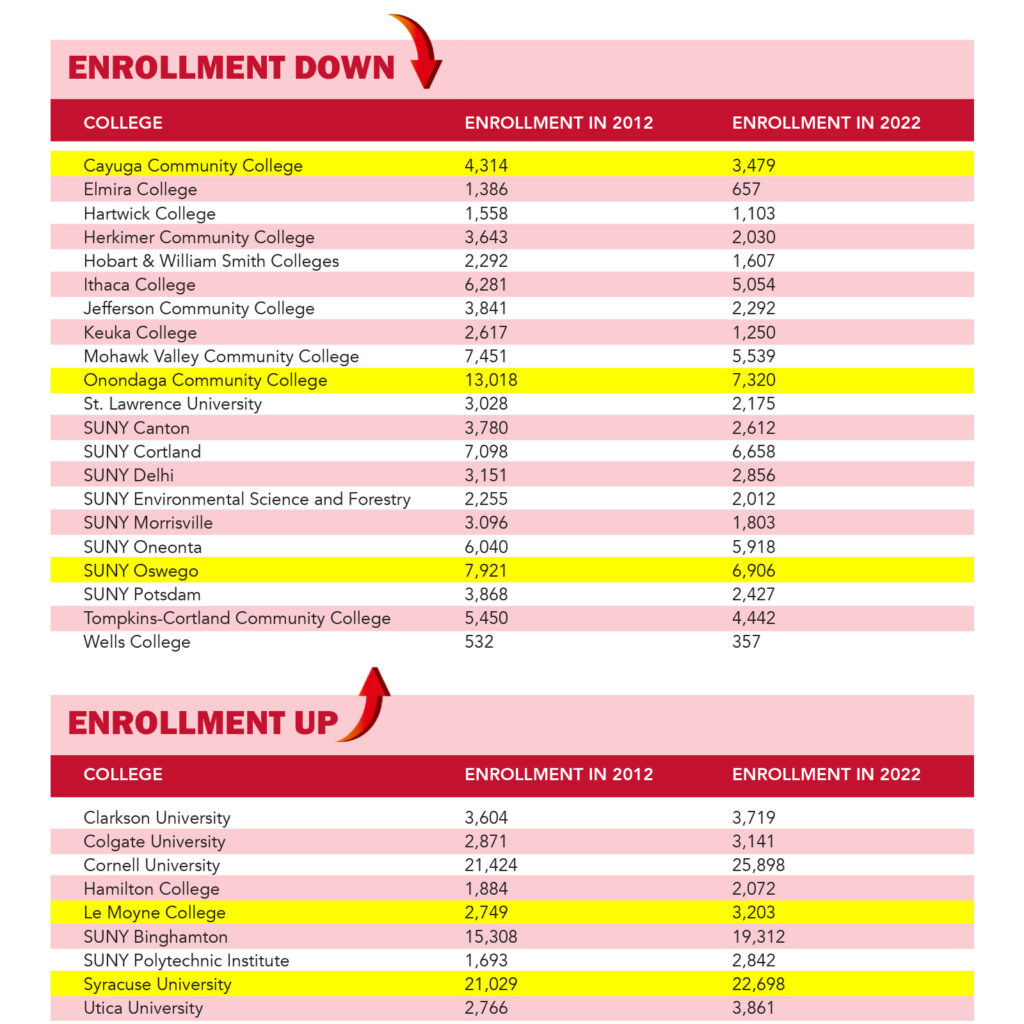Many higher education institutions struggle with debt, lack of students
By Aaron Gifford
 These days, it’s not unusual for high school seniors to be inundated with emails from colleges they never showed interest in or never even heard of.
These days, it’s not unusual for high school seniors to be inundated with emails from colleges they never showed interest in or never even heard of.
It’s a sign of desperation when the number of higher education institutions in the United States far exceeds the number of available or interested students. According to a recent report from MyLearningWorld.com, college enrollment nationwide went down 12.8% or 2.1 million students, in the past decade.
In the past year for New York state alone, three small private schools closed or announced they will be closing following years of shrinking enrollments — Cazenovia College, Medaille College in Buffalo and the College of
Saint Rose in Albany.
Dozens of other colleges and universities in New York state, public and private, are struggling financially and with declining enrollments, as are hundreds more across the country, according to statistics from the National Center for Education Statistics.
The national decrease is attributed to declining birth rates, skyrocketing tuition costs, a growing number of certificate programs that prepare students for careers right out of high schools and the increase of online degree programs that benefit some schools to the detriment of others.
Schools use money from their endowments to cover scholarships. Endowments are typically funded by alumni donations and can also be used for new programs and capital projects. At many less competitive small private colleges, alumni contributions are relatively small and less frequent. By contrast, the endowments at elite private institutions like Colgate University or Hamilton College are approaching or exceeding $1 billion and grow faster than they are spent down. Cazenovia College’s endowment at the time of its closure last year was only $4.1 million, not enough to cover its debts, let alone fund future scholarships to deeply discount its $54,000 per year sticker price.
Campus closures hurt local economies that relied on students and employees to spend money at restaurants and stores, not to mention money leaving the real estate and housing rental markets. Fewer college graduates affect the national economy because individuals who chose not to pursue a degree are likely to make less money. MyLearningWorld estimates that economic impact at $2 trillion in lifetime earnings per 2.1 million students that don’t earn a four-year degree.

New York City.
André Torres, director of guidance at Manhattan Bridges High School in New York City, said school closures in recent years have changed the way guidance counselors do their jobs. His alma mater, the College of New Rochelle in Westchester County, closed in 2019 after declaring bankruptcy. Not only does Torres research enrollment and financial trends of schools, he also pays attention to which ones are cutting academic majors and programs.
“You have to keep in mind that some of these schools may not be around for very long,” he said.
Most of the students from Manhattan Bridge High School are minorities and come from low-income households. Torres said SUNY schools have been increasingly aggressive in student recruiting efforts in recent years, yet he is aware of very few students who have taken advantage of the state’s Excelsior program that pays full SUNY tuition for income-eligible students. Rather, he said, high-achieving students are getting a better deal at private schools, including several who went to Cornell University or Carnegie Mellon in Pittsburgh on full academic scholarships.
In response to the fierce competition for students between public and private universities, Gov. Kathy Hochul recently proposed a plan to automatically admit students in the top 10% of their class into the most competitive SUNY schools, which includes the university centers in Albany, Buffalo, Binghamton and Stonybrook. The policy, which does not yet detail scholarship or financial aid components beyond automatic admission, will be mulled over by state officials in the months ahead.
Paul Hassen, communications and marketing director for the National Association of Independent Colleges and Universities, said the main factor is demographics. In addition to a shrinking population of people in their late teens and early 20s compared to decades past, there has been a major population shift to the southeastern or western parts of the country from the northeast, where there’s an abundance of colleges, public and private. He said a number of community colleges and four-year schools in the SUNY system are operating at $10 million or $20 million deficits, as exemplified by the recent announcement that the current Clinton Community College campus will close and relocate to the nearby SUNY Plattsburgh campus by 2025. SUNY Fredonia will cut 13 low-performing degree programs to close its budget gap, while Buffalo State College enacted a hiring freeze in response to its $16 million deficit.
The NAICU challenges small liberal arts colleges to be more competitive by replacing some traditional majors with programs that are either more popular or lead to better career prospects. That list includes health sciences, artificial intelligence, cybersecurity and sports management. Schools can also add sports teams, like football or lacrosse, which require large rosters. While doing so may require an upfront investment in staff, facilities and equipment, the school can boost enrollment with dozens more students and take in more than enough tuition money over a short amount of time to cover those costs, Hassen explained.
“Esports is also becoming very popular,” Hassen said. “Schools should be asking themselves, ‘what do we need to do to attract an 18-year-old today?’”
Hassen said small colleges also need to assure they are “right sizing” their staffing levels based on the number of students. Many schools across the nation are grossly overstaffed. And many have also relaxed their enrollment goals too much in recent years. It’s not acceptable for a school that traditionally had 1,000 students a year to tally 970 or 980 students for three or four consecutive years.
“Hitting the enrollment target is a critical point,” he said. “If they [small colleges] don’t have debt, there’s a lot they can do to remain financially viable.”
Russell Sage College in Albany reduced its deficit from $20 million to $8 million over a four-year period by merging two separate campuses (Russell Sage Colleges was originally two schools, one for men and the other for women) into a single school, boosting enrollment slightly, cutting several programs and obtaining donations to fund some of the costs for upcoming capital projects, according to a January story in the Albany Times Union.
The Council of Independent Colleges recently published a collection of success stories from small private schools It notes how Eastern University’s (Pennsylvania) enrollment increased from 3,059 in 2019 to 6,112 in 2023 after that school added online courses and football, cheer, dance and sports teams. Culver-Stockton College in Missouri increased its 2023 enrollment to 356, up 25 from the prior year, after that school strengthened relations with local high schools and alumni network and opened its doors to transfers from other nearby colleges.
Nationwide, the average annual sticker price at public colleges (four-year schools) and universities this academic year for in-state residents is $11,260 and for out-of-state residents $29,150. That’s an annual increase from the previous year of 2.5% and 3.0%, respectively. For private schools, the average sticker price for 2023-2024 is 41,450, up 4% from last year, according to the College Board.
Hassen noted that the list of free tuition or loan-free programs for income-eligible programs at private nonprofit colleges for 2024-2025 is quite long. This includes Aquinas College (Michigan), Baker College (Michigan), Olivet University (Michigan), Bethel University (Indiana), Nebraska Wesleyan University, Grand View University (Iowa), Farleigh Dickson University (New Jersey), Houghton University (New York), Roanoke College (Virginia) and Washington & Jefferson University (Pennsylvania). And at Colby-Sawyer College in New Hampshire, the annual cost to attend will be cut by 60%, from $46,374 to $17,500.
In Upstate New York, many colleges and universities that recruit students from Oswego County and the Central New York area have reported enrollment decreases in the past decade (2012 to 2022). according to the National Center for Education Statistics.





